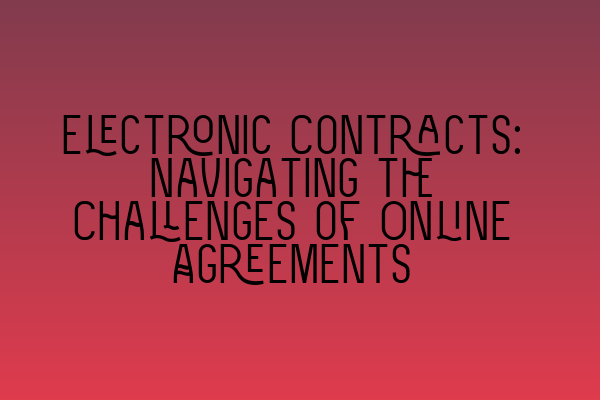Electronic Contracts: Navigating the Challenges of Online Agreements
Gone are the days of paper contracts and lengthy negotiations. In today’s digital age, electronic contracts have become the new norm. With just a few clicks, you can enter into a legally binding agreement without even leaving your home. However, while electronic contracts offer convenience and efficiency, they also come with their own unique set of challenges. In this blog post, we will explore the world of electronic contracts and discuss how to navigate through their complexities.
The Rise of Electronic Contracts
The advent of the internet has revolutionized the way we do business. Online platforms and e-commerce websites allow parties from different corners of the world to connect and transact seamlessly. From purchasing goods to rendering services, electronic contracts have become the backbone of these transactions.
Electronic contracts, also known as e-contracts, are essentially agreements formed electronically, without the need for physical signatures or exchanges of paper. These contracts can take various forms, including website terms of service, clickwrap agreements, browsewrap agreements, and electronic signatures.
Challenges of Online Agreements
While electronic contracts offer numerous advantages, they also present unique challenges compared to traditional contracts. It is crucial for businesses and individuals to be aware of these challenges to ensure the validity and enforceability of their agreements.
1. Consent and Communication
One of the fundamental requirements for a contract is the mutual consent of the parties involved. However, establishing the intent to enter into a contract online can be more complex than in face-to-face interactions. It is essential for businesses to ensure that users clearly understand and agree to the terms and conditions before proceeding with the transaction.
Effective communication is key when it comes to electronic contracts. Businesses must use clear and concise language to express their terms, avoiding any ambiguity that could lead to disputes down the line. Incorporating interactive features and user-friendly interfaces can also enhance the user experience and encourage informed consent.
2. Authentication and Security
Authenticating the identity of the parties involved in an electronic contract is another challenge. Without physical signatures or face-to-face interactions, it becomes crucial to establish reliable methods of authentication. This is where electronic signatures play a vital role.
Electronic signatures, such as digital signatures or biometric signatures, help verify the identity and intent of the parties involved. These signatures provide a secure and tamper-evident way to confirm agreement to the contract terms. However, it is important to comply with applicable electronic signature laws and industry standards to ensure the validity and legality of these signatures.
3. Jurisdiction and Governing Law
With online transactions crossing geographical boundaries, determining the proper jurisdiction and applicable governing law can be challenging. Different countries and regions have varying laws concerning electronic contracts, which can lead to conflicts and jurisdictional disputes.
Businesses must carefully consider the choice of law and jurisdiction clause in their electronic contracts to mitigate potential legal challenges. Consulting with legal professionals who specialize in international contract law can help ensure compliance with local regulations and streamline dispute resolution processes.
Best Practices for Electronic Contracts
Despite the challenges, electronic contracts can be navigated successfully. By following some best practices, businesses can minimize risks and maximize the benefits of these agreements:
- Clearly present the terms and conditions in a user-friendly format, eliminating complex legal jargon.
- Implement robust authentication methods to ensure the integrity of electronic signatures.
- Regularly update and review electronic contract templates to reflect changes in the law.
- Include an appropriate choice of law and jurisdiction clause to specify the applicable legal framework.
- Keep meticulous records of all electronic contracts and communications to facilitate dispute resolution, if necessary.
In Conclusion
Electronic contracts have become an integral part of the digital economy, providing convenience and efficiency in conducting business online. However, navigating the challenges of online agreements requires careful consideration of consent, authentication, jurisdiction, and governing law.
By understanding these challenges and implementing best practices, businesses and individuals can enter into electronic contracts with confidence, knowing that their agreements are valid, enforceable, and compliant with applicable laws.
If you require legal advice or guidance regarding electronic contracts, our team of experienced solicitors at SQE Contract Law is here to help. Contact us today to ensure your electronic contracts are secure, legally sound, and tailored to your specific needs.
